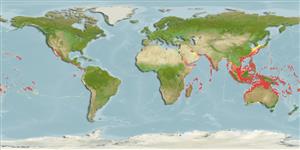Common names from other countries
Classification / Names / Names
Nomi Comuni | Sinonimi | Catalog of Fishes (gen., sp.) | ITIS | CoL | WoRMS
Environment: milieu / climate zone / depth range / distribution range
Ecologia
; distribuzione batimetrica 0 - 120 m (Ref. 96667). Tropical
Indo-Pacific. Tropical to subtropical.
Length at first maturity / Size / Peso / Age
Maturity: Lm ? range ? - ? cm
Found along the neritic zone, in reef areas (Ref. 97241). Subtidal (Ref. 106854). Occurs on sand and rocks at intertidal depths (Ref. 077872). A free-living predatory carnivore (Ref. 97241). Observed to feed on juvenile tridacnid clams in aquaria (Ref. 108392). Omnivorous diet in Moreton Bay (Ref. 113556).
Life cycle and mating behavior
Maturità | Riproduzione | Deposizione | Uova | Fecundity | Larve
Members of the order Decapoda are mostly gonochoric. Mating behavior: Precopulatory courtship ritual is common (through olfactory and tactile cues); usually indirect sperm transfer.
Gibbs, P.E. 1978. (Ref. 3197)
IUCN Red List Status (Ref. 130435)
CITES status (Ref. 108899)
Not Evaluated
Not Evaluated
Human uses
| FishSource |
Strumenti
Informazioni ulteriori
Age/Size
Accrescimento
Length-weight
Length-length
Morfologia
Larve
Abbondanza
Fonti Internet
Estimates based on models
Preferred temperature
(Ref.
115969): 24.3 - 29, mean 27.9 (based on 2078 cells).
Price category
Unknown.
